How to install XPipe on Linux
This article will show you how to install XPipe on Linux as well as manage your own VPS and Docker hub.
Download and install XPipe
The first step in installing XPipe in Linux is to ensure that the system is fully updated. To do that, run the following command in terminal on Debian and Ubuntu:
sudo apt update && sudo apt upgradeIn Fedora, you can instead run the following command to update your system:
sudo dnf updateOpen a web browser, then navigate to the latest releases page for XPipe.
Scroll down to the 'installers' heading, then select the appropriate installer format for the system. For Debian-based systems, select the 'Linux .deb installer (x86_64)' link. For Fedora-based systems, select 'Linux .rpm installer (x86_64)'.

Note : You can also install XPipe on Raspberry Pi by selecting 'Linux .deb installer (arm64)'.
Return to the terminal session, then navigate to the Downloads folder on your device:
cd ~/DownloadsInstall the XPipe bundled installer using the Ubuntu/Debian package manager:
sudo apt install ./xpipe-installer-linux-x86_64.debFor Fedora, you can run the following command:
sudo dnf install ./xpipe-install-linux-x86_64.rpmOpen the app launcher on your system, type 'xpipe' in the search bar, then click on the app's icon.
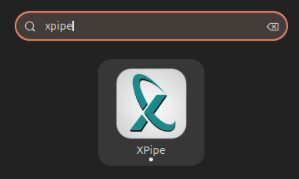
Check the I accept the End User License Agreement checkbox , then click Confirm to load the XPipe control panel.

Connect to the remote server first
At this point, you should have a completely blank XPipe client running on your current desktop session. To use it with a remote server, first make sure it can detect the machine's local shell.
Start by clicking the Search for Connections button on the program's main screen.

This will open a small window where XPipe will ask you to select the sources it will poll in your machine. Accept the default values, then click Finish .
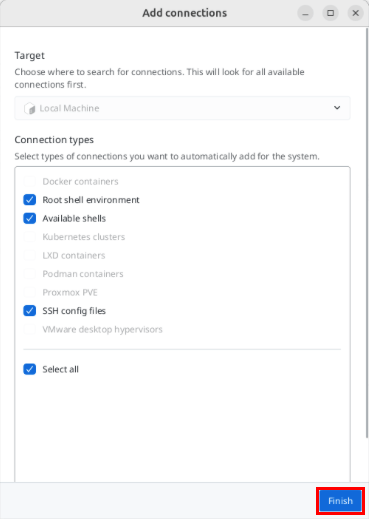
Once XPipe detects both the root shell and the regular user shell, click the + New button in the upper left corner of the program window.
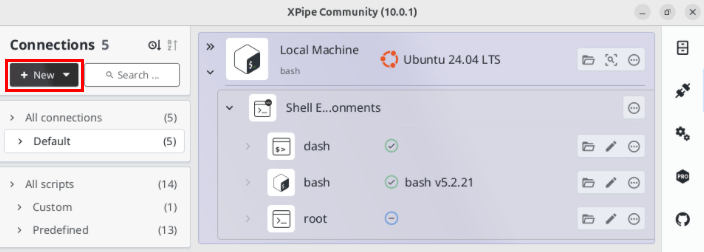
Select Remote Host -> Simple SSH Connection .
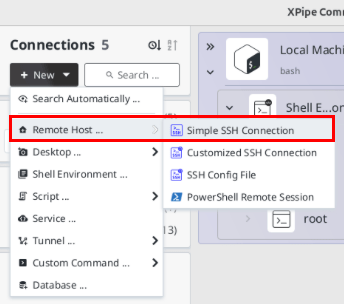
Configure server details in XPipe
Click the Host text box under Connection Information , then provide the domain name or IP address of the remote machine.
Select the User text box , then enter the name of the user you want to connect to your server with.

Scroll down to the authentication section, then provide your user account password or associated SSH key.
If you are using a password for the SSH server, click the Password-based Authentication drop-down box , select Password , then provide the user account password in the text box below.

Meanwhile, if you are using an SSH key, select the Key-based Authentication drop-down menu , select Identity File , then provide the location of the public SSH key file.
Note : Make sure to set other authentication options to None if you only use one of the two methods.
Go to the Connection Name section , name the new SSH setup, then click Finish to save.
Finally, XPipe will try to find existing containers and services running on the remote server. Accept the default values, then click Finish again to begin.
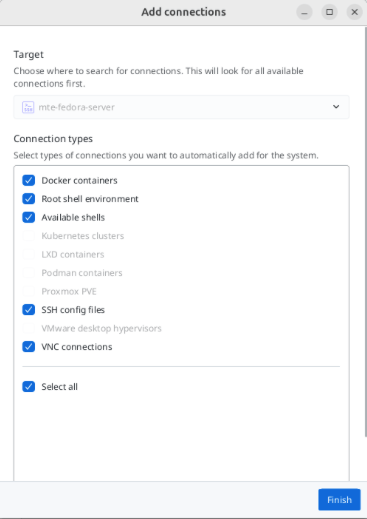
You should read it
- 5 reasons to install Linux on old computers
- How to install Kali Linux on macOS
- How to install NVIDIA drivers on Kali Linux
- Steps to install Webex for Linux
- How to install Kali Linux on Android using Linux Deploy
- How to install Windows Game on Linux with Winepak
- Instructions for installing basic Arch Linux
- How to install Kali Linux on your computer
May be interested
- How to install Spotify on Linux
 spotify has actually supported linux for a long time. although most distributions do not include this application in the repository for license reasons, it is not really difficult to install this official player on a linux pc.
spotify has actually supported linux for a long time. although most distributions do not include this application in the repository for license reasons, it is not really difficult to install this official player on a linux pc. - How to Install VirtualBox on Linux
 setting up a virtual machine can be a great way to test alternative software or operating systems on a computer without altering or putting the existing system at risk.
setting up a virtual machine can be a great way to test alternative software or operating systems on a computer without altering or putting the existing system at risk. - How to install Deepin Linux
 deepin linux is an excellent distribution. so why not experience it on your computer? deepin has a variety of high-quality layouts / interfaces and great software.
deepin linux is an excellent distribution. so why not experience it on your computer? deepin has a variety of high-quality layouts / interfaces and great software. - How to Install Asahi Linux on an Apple Silicon Mac
 asahi linux is a project to port the linux kernel and related software to macs powered by apple silicon. it is still under development, but it has made significant progress in a short period of time.
asahi linux is a project to port the linux kernel and related software to macs powered by apple silicon. it is still under development, but it has made significant progress in a short period of time. - How to install and use TeamViewer on Linux
 teamviewer is a powerful tool that allows teams to collaborate and share their screens in real time. it is also extremely useful in remote technology support.
teamviewer is a powerful tool that allows teams to collaborate and share their screens in real time. it is also extremely useful in remote technology support. - How to Install Linux
 linux is the foundation of thousands of open source operating systems designed to replace windows and mac os. linux allows users to download and install it for free on any computer. because this is an open source platform, the number of available versions or distributions is very diverse and is developed by many different organizations. follow the basic instructions below to install all linux versions, especially some of the most popular distributions.
linux is the foundation of thousands of open source operating systems designed to replace windows and mac os. linux allows users to download and install it for free on any computer. because this is an open source platform, the number of available versions or distributions is very diverse and is developed by many different organizations. follow the basic instructions below to install all linux versions, especially some of the most popular distributions. - Should I install Arch Linux?
 arch linux is one of the most popular linux operating systems. arch linux is even easier to install than arch-based distributions like manjaro and antergos.
arch linux is one of the most popular linux operating systems. arch linux is even easier to install than arch-based distributions like manjaro and antergos. - How to install Handbrake on Linux
 handbrake is a powerful open source tool for encoding and editing videos. it includes a graphical control panel to manage encryption and even preview the results.
handbrake is a powerful open source tool for encoding and editing videos. it includes a graphical control panel to manage encryption and even preview the results. - How to install and remove fonts on Linux
 the linux system has many integrated fonts but you still can't find the font you need. downloading and installing new fonts is very easy on linux and we will show you how to do this in the following article.
the linux system has many integrated fonts but you still can't find the font you need. downloading and installing new fonts is very easy on linux and we will show you how to do this in the following article. - How is Arch Linux different from other Linux versions?
 arch linux is arguably the most misunderstood linux distribution. many people find arch difficult to install and maintain.
arch linux is arguably the most misunderstood linux distribution. many people find arch difficult to install and maintain.









 Should I buy an Intel, AMD or Apple AI CPU?
Should I buy an Intel, AMD or Apple AI CPU? Microsoft officially closed all retail stores in China
Microsoft officially closed all retail stores in China Hackers encrypted all data, the Indonesian Government discovered there was no back-up
Hackers encrypted all data, the Indonesian Government discovered there was no back-up The world's largest rain simulation system
The world's largest rain simulation system How to download YouTube videos to iPhone
How to download YouTube videos to iPhone How to display My Computer, This PC on Windows 10 Desktop
How to display My Computer, This PC on Windows 10 Desktop